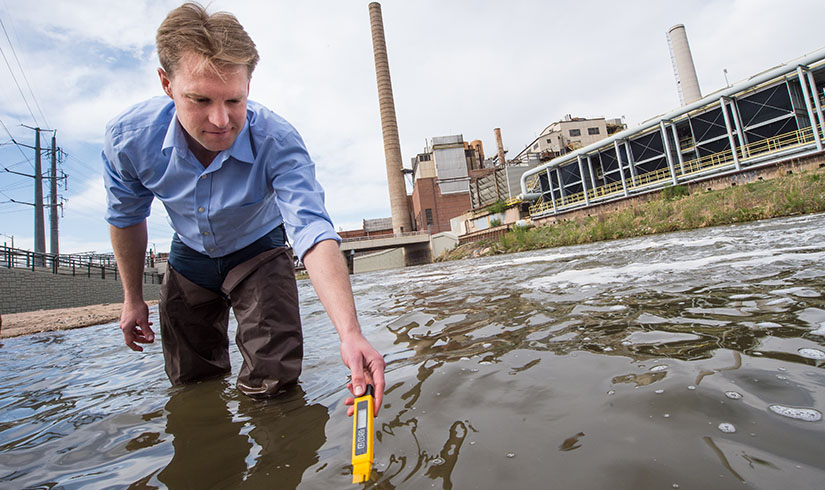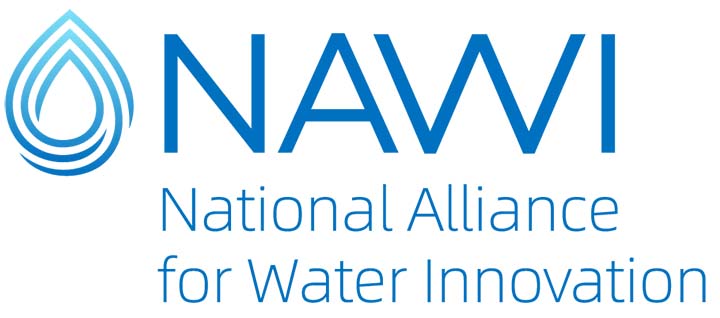National Alliance for Water Innovation
NLR is one of four national laboratories leading the National Alliance for Water Innovation (NAWI), a 6-year, $110 million energy-water desalination hub funded by the U.S. Department of Energy.

NAWI is designed to address water security issues in the United States by focusing on early-stage R&D for energy-efficient and cost-competitive desalination technologies.

The strategic goal of NAWI is to conduct early-stage applied research, leading to a portfolio of technologies that enable pipe parity for 90% of nontraditional water sources. To achieve this goal, NAWI is working to:
- Secure a circular U.S. water economy by acquiring water supplies from nontraditional sources
- Develop technologies to enable pipe parity
- Enhance the economic, environmental, and energy security of the United States.
Led by a team from NLR, Lawrence Berkeley National Laboratory, National Energy Technology Laboratory, and Oak Ridge National Laboratory, this research consortium includes industry partners and leading U.S. research universities and NAWI's public membership organization, the NAWI Alliance.
Become a thought leader in clean water innovation and join the NAWI Network today to unite with world-class lab, industry, and academic experts to address some of the greatest water and energy security challenges.
Research Areas
- Data, modeling, and analysis (DMA) of nontraditional water sources as well as water treatment materials, processes, and treatment trains (completed)
- Process innovation and intensification to develop novel and intensified processes as well as autonomous and adaptable water systems
- Materials and manufacturing innovations to accelerate the adoption of new materials in water desalination systems.
- Devices looking into cost-effective, energy-efficient technologies in the desalination and fit-for-purpose reuse spaces
- Treatment trains exploring innovations and approaches to integrated water treatment and production systems through optimal design, and advanced controls and sensing networks at the plant-wide level
- Regional water systems identifying when, where, and how nontraditional water technologies can advance water reliability and affordability goals in a regional water systems context.
Capabilities
NLR leads NAWI's DMA topic area, which includes modeling and analysis. NLR is enabling advanced water technology research by:
- Providing a secure and publicly accessible data management system
- Developing a standardized open-source analytical platform for consistently evaluating pipe parity of technologies treating nontraditional water sources
- Conducting innovative systems-level and technology-specific analyses on high-priority research topics.
As part of this effort, NLR developed the Water treatment Technoeconomic Assessment Platform (WaterTAP), an open-source, Python-based software package that supports the techno-economic assessment of full water treatment trains. WaterTAP is available on GitHub with documentation.
WaterTAP is the merged capability of two previous NAWI modeling efforts: WaterTAP3 and ProteusLib. WaterTAP3 built simple data-driven models for greater than 50 water treatment technologies with the objective of screening technologies, performing baseline analyses of alternative source waters, and developing NAWI technology roadmaps. ProteusLib built physics-based predictive models focusing on reverse osmosis desalination, including pretreatment, post-treatment, and mineral scaling with the objective of evaluating emerging reverse osmosis (i.e., high-pressure and low-salt-rejection) technologies.
Current WaterTAP development is focusing on expanding the detailed, physical-based models for other water treatment technologies.
NLR performs innovative analyses that help define current baseline cost and performance characteristics of water treatment technologies as well as inform future strategic NAWI investments in R&D. The analysis team utilizes the Water DAMS, WaterTAP, and other analytical tools to assist in guiding NAWI's research investment decisions and quantifying NAWI's research impact. Outputs also include publicly accessible information resources, publications, and analytical tools, including baseline analyses of alternative source waters and the NAWI technology roadmaps.
Analysis activities are focused on quantifying the effects of targeted improvements in material and components performance on pipe parity metrics by performing parametric and statistical analysis using techno-economic and optimization models. Analysis activities also quantify the cost and/or energy effects of process intensification or elimination of specific unit processes enabled by improved performance of surrounding unit processes.
Impacts
NLR's DMA activities led to the publication of NAWI's foundational roadmap and baseline publication series, which guide NAWI's R&D investments. The five technology roadmaps and NAWI Master Roadmap help prioritize NAWI technology research, and the eight source-water baseline studies provide benchmarks for assessing NAWI advancements.
Roadmaps
With support from NLR, NAWI's series of roadmap publications play an important role in disseminating information necessary to guiding desalination innovations.
The Master Roadmap represents NAWI's investment strategy for technology advancements that will enable a circular water economy. It also synthesizes the results of the 2020 NAWI Roadmapping initiative, which focused on technical challenges across five sectors: agriculture, industrial, municipal, power, and resource extraction (mining and oil and gas exploration and production).
With support from NLR, NAWI published five end-use water roadmaps with tailored R&D and modeling opportunities for each sector: agriculture, industrial, municipal, power sector, and resource extraction. These roadmaps aim to advance desalination and treatment of nontraditional source waters for beneficial use in public water supplies by identifying research and development opportunities that overcome treatment challenges.
Visit NAWI's roadmap publication series web page to learn more about these five publications.
Agricultural Sector Technology Roadmap, NAWI Technical Report (2021)
Industrial Sector Technology Roadmap, NAWI Technical Report (2021)
Municipal Sector Technology Roadmap, NAWI Technical Report (2021)
Power Sector Technology Roadmap, NAWI Technical Report (2021)
Resource Extraction Sector Technology Roadmap, NAWI Technical Report (2021)
Baseline Metrics
To build a circular water economy, the country must adopt advanced water treatment technologies and make use of alternative water resources. To facilitate the improvement and adoption of advanced water treatment technologies, it is essential to understand their current cost and performance capabilities across different water types and sectors.
One of NAWI's first activities was to develop baseline metrics and foundational case studies to represent standard water treatment plants that treat eight alternative water resources, including agricultural runoff, seawater, brackish groundwater, oil-and-gas-produced water, municipal wastewater, industrial wastewater, mining wastewater, and power sector water. NLR coordinated efforts across universities, national laboratories, and industry partners to create these baseline studies.
Baseline Publications
Access the special issue of ACS ES&T Engineering to see all eight of the following articles.
Agriculture
Opportunities for Treatment and Reuse of Agricultural Drainage in the United States, ACS ES&T Engineering (2021)
Industrial
Opportunities and Challenges for Industrial Water Treatment and Reuse, ACS ES&T Engineering (2021)
Municipal
Cost and Energy Metrics for Municipal Water Reuse, ACS ES&T Engineering (2021)
Brackish Groundwater
Analysis of Brackish Water Desalination for Municipal Uses: Case Studies on Challenges
and Opportunities, ACS ES&T Engineering (2021)
Seawater
Pipe Parity Analysis of Seawater Desalination in the United States: Exploring Costs,
Energy, and Reliability via Case Studies and Scenarios of Emerging Technology, ACS ES&T Engineering (2021)
Power
Zero Liquid Discharge and Water Reuse in Recirculating Cooling Towers at Power Facilities:
Review and Case Study Analysis, ACS ES&T Engineering (2021)
Mining
Mine Water Use, Treatment, and Reuse in the United States: A Look at Current Industry
Practices and Select Case Studies, ACS ES&T Engineering (2021)
Produced Water From Oil and Gas
Oil and Gas Produced Water Reuse: Opportunities, Treatment Needs, and Challenges, ACS ES&T Engineering (2021)
Partners
All this work is made possible through the collaboration of a vast group, including:
- University partners: Colorado School of Mines, Colorado State University, New Mexico State University, Texas A&M University, University of California Irvine, University of Southern California, University of Texas at Austin, University of Cincinnati, University of Colorado Boulder, Washington University in St. Louis, and Yale University
- Industry partners: Electric Power Research Institute and multiple water treatment facilities
- National laboratory partners: Lawrence Berkeley National Laboratory, National Energy Technology Laboratory, and Oak Ridge National Laboratory.
Contacts
Share
Last Updated Dec. 7, 2025
